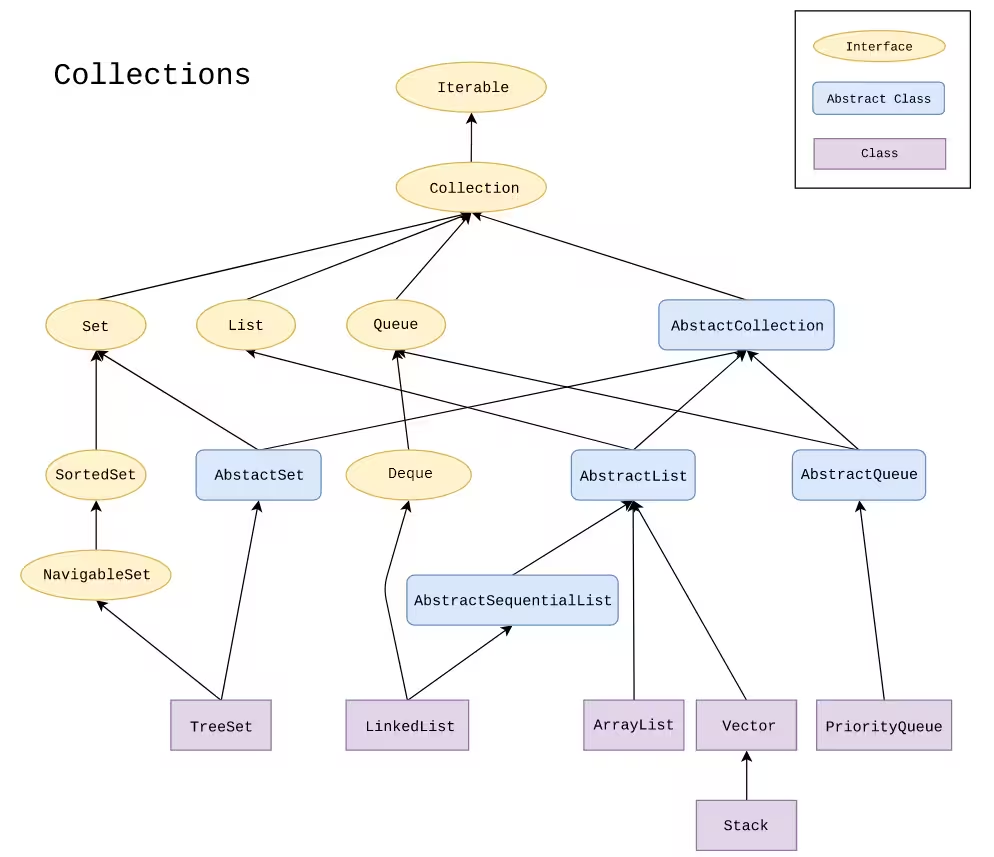Java Collection Framework - JCF
All classes that permit the handling of groups of objects constitute the Java Collection Framework.
A Collection is a container in which several objects are grouped in a single entity.
The Java Collection Framework is constituted by:
- Interfaces the define the operations of a generic collection. They can be split into two categories:
- Collection: used to optimize operations of insertion, modification and deletion of elements in a group of objects.
- Map: optimized for look-up operations.
- Classes that implement the interfaces using different data structures.
- Algorithms consisting in methods to operate over a collection.

java.util.Collections
Collection Functions
| Java |
|---|
| boolean add (Object o) e.g., <x>.add (<y>) //append to collection, false if fails
boolean add (int index, Object o) //insertion at given index
boolean addAll (Collection c) //appends a collection to another
void clear() //remove items from container
boolean contains (Object o) //true if object is in collection
boolean containsAll (Collection c) //true if all items of collection are in another
boolean isEmpty (Object o) e.g., if (<x>.isEmpty()) ... //true if collection is empty
boolean remove (Object o) //remove object from collection
Object remove (int index) //remove object at given index
void removeAll (Collection c) //remove all items form collection
int size () //number og items in collection
Object [] toArray() //transform collection in array
Iterator iterator() //returns iterator to iterate over the collection
|
Collections Methods
| Java |
|---|
| Collection<E>.forEach(Consumer<? super T> action);
|
Iterator
Abstracts the problem of iterating over all the elements of a collection;
public Iterator (Collection c) creates the Iteratorpublic boolean hasNext() checks if there is a successive elementpublic Object next() extracts the successive element
ArrayList
Note: ArrayLists can't contain primitive values. Use wrapper classes instead.
| Java |
|---|
| import java.util.ArrayList;
ArrayList<Type> ArrayListName = new ArrayList<Type>(starting_dim); //resizable array
ArrayList<Type> ArrayListName = new ArrayList<Type>(); //resizable array
ArrayList<Type> ArrayListName = new ArrayList<>(); //resizable array (JAVA 1.8+)
ArrayListName.add(item); //append item to collection
ArrayListName.add(index, item); // add item at position index, shift all item from index and successive towards the end af the ArrayList
ArrayListName.set(index, item); // substitute EXISTING item
ArrayListName.get(index); //access to collection item
ArrayListName.remove(item) //remove first occurrence of item from collection
ArrayListName.remove(index) //remove item at position index
ArrayListName.clear() //empties the ArrayList
ArrayListName.contains(object); // check if object is in the ArrayList
ArrayListName.IndexOf(object); // returns the index of the object
ArrayListName.isEmpty(); // check wether the list is empty
ArrayListName.size(); //dimension of the ArrayList
ArrayListName.tirmToSize(); // reduce ArrayList size to minimum needed
// ArrayList size doubles when a resize is needed.
//run through to the collection with functional programming (JAVA 1.8+)
ArrayListName.forEach(item -> function(v));
|
Collection Sorting
To sort a collection it's items must implement Comparable<T>:
| Java |
|---|
| class ClassName implements Comparable<ClassName> {
@override
public int compareTo(Classname other){
//compare logic
return <int>;
}
}
List<ClassName> list;
//valorize List
Collections.sort(list); //"natural" sorting uses compareTo()
|
Otherwise a Comparator() must be implemented:
| Java |
|---|
| class Classname {
//code here
}
// Interface object (!) implements directly a method
Comparator<ClassName> comparator = new Comparator<ClassName>() {
@Override
public int compare(ClassName o1, Classname o2) {
//compare logic
return <int>;
}
};
List<ClassName> list;
//valorize List
Collections.sort(list, comparator); //"natural" sorting uses compareTo()
|
Comparator<T> and Comparable<T> are functional interfaces
